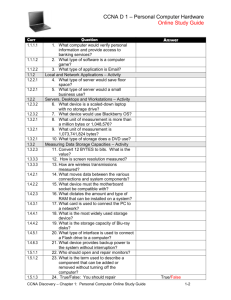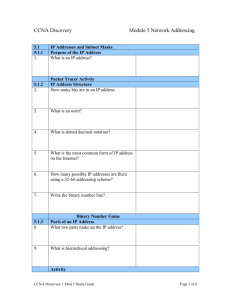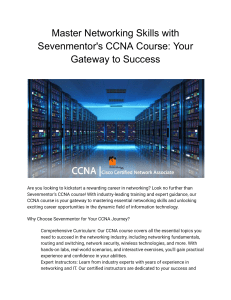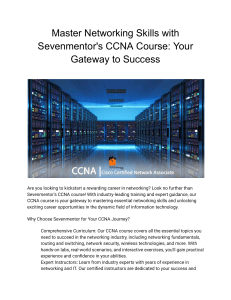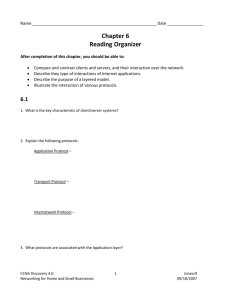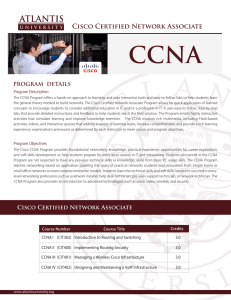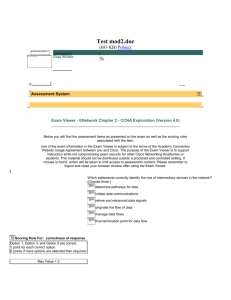Cisco I Module 5 Study Guide
advertisement
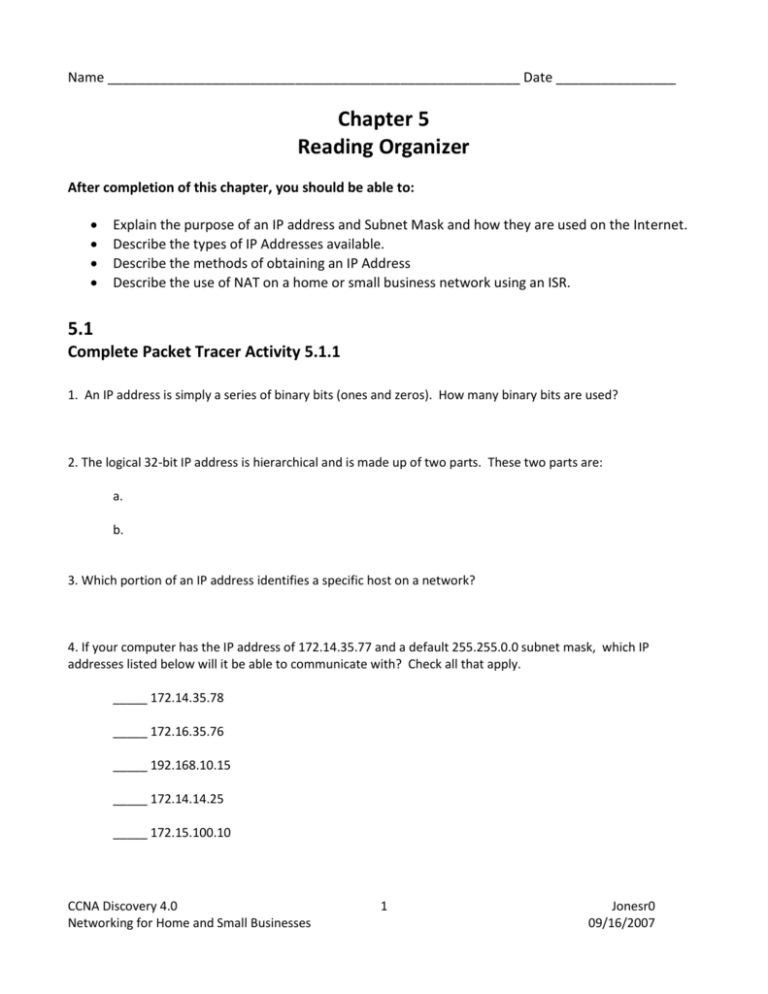
Name _______________________________________________________ Date ________________ Chapter 5 Reading Organizer After completion of this chapter, you should be able to: Explain the purpose of an IP address and Subnet Mask and how they are used on the Internet. Describe the types of IP Addresses available. Describe the methods of obtaining an IP Address Describe the use of NAT on a home or small business network using an ISR. 5.1 Complete Packet Tracer Activity 5.1.1 1. An IP address is simply a series of binary bits (ones and zeros). How many binary bits are used? 2. The logical 32-bit IP address is hierarchical and is made up of two parts. These two parts are: a. b. 3. Which portion of an IP address identifies a specific host on a network? 4. If your computer has the IP address of 172.14.35.77 and a default 255.255.0.0 subnet mask, which IP addresses listed below will it be able to communicate with? Check all that apply. _____ 172.14.35.78 _____ 172.16.35.76 _____ 192.168.10.15 _____ 172.14.14.25 _____ 172.15.100.10 CCNA Discovery 4.0 Networking for Home and Small Businesses 1 Jonesr0 09/16/2007 5. Draw a line between the PC’s and the correct network they can communicate with. Complete Lab Activity 5.1.4 5.2 6. Expand on the following address classes. (ie. How their octets are divided, what the default subnet mask is, and where that class of address is commonly used.) a. Class A – b. Class B – c. Class C – CCNA Discovery 4.0 Networking for Home and Small Businesses 2 Jonesr0 09/16/2007 7. What is the first octet range of all five address classes? Class A –__________________________________ Class B –__________________________________ Class C –__________________________________ Class D –__________________________________ Class E –__________________________________ 8. All hosts that connect directly to the Internet require a unique public IP address. Explain in detail why this is a problem, and give one possible solution. 9. How many private host addresses are available for each class of address? a. Class A – __________________________________ b. Class B – __________________________________ c. Class C –__________________________________ 10. How many networks are available for each class of private addresses? a. Class A –__________________________________ b. Class B –__________________________________ c. Class C –__________________________________ CCNA Discovery 4.0 Networking for Home and Small Businesses 3 Jonesr0 09/16/2007 11. List the private address network ranges for each class of address. a. Class A – __________________________________ b. Class B – __________________________________ c. Class C –__________________________________ 12. What is an advantage of using private addresses? 13. What is the address range 127.0.0.0 used for? 14. Where is a unicast packet destined to go? 15. For a unicast packet to be sent and received, what must be included? 16. List the default broadcast addresses for the following IP addresses. a. 192.168.1.0 - __________________________________ b. 172.16.0.0 - __________________________________ c. 10.0.0.0 - __________________________________ d. 210.25.77.0 - __________________________________ e. 145.188.0.0 - __________________________________ CCNA Discovery 4.0 Networking for Home and Small Businesses 4 Jonesr0 09/16/2007 17. What is the MAC address of a multicast address always start with? 5.3 18. Explain in detail how static and dynamic addresses work, and their advantages and disadvantages. Static – Advantages - Disadvantages – Dynamic – Advantages – CCNA Discovery 4.0 Networking for Home and Small Businesses 5 Jonesr0 09/16/2007 19. What is the purpose of a DHCP server? 20. Explain in detail how a computer uses a DHCP server to get its IP address? Complete Packet Tracer Activity 5.3.3 5.4 21. What is each interface on a router connected to? 22. List and explain the three methods hosts can be connected to an ISP. a. __________________________________- b. __________________________________- c. __________________________________- CCNA Discovery 4.0 Networking for Home and Small Businesses 6 Jonesr0 09/16/2007 23. Explain what NAT is and does. Complete Packet Tracer Activity 5.4.3 CCNA Discovery 4.0 Networking for Home and Small Businesses 7 Jonesr0 09/16/2007

